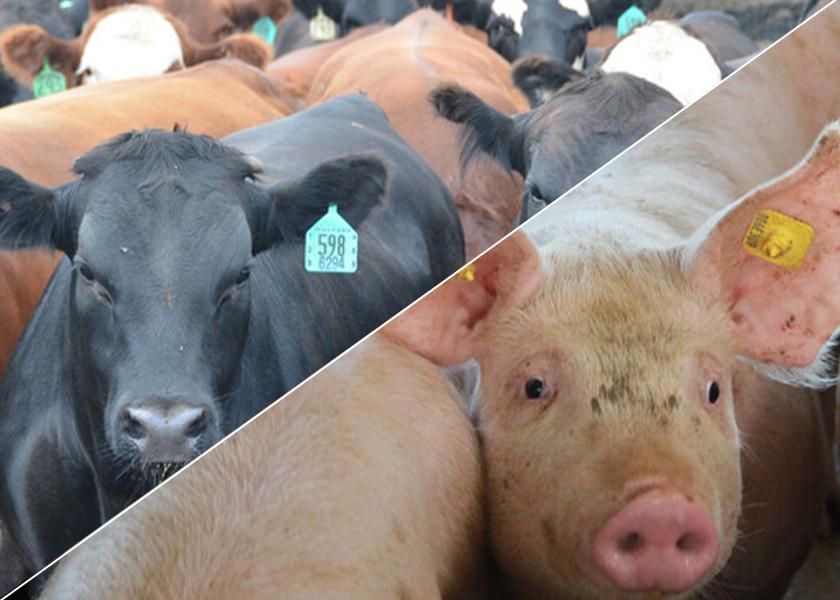Livestock Analysis | June 17, 2022

Price action: July lean hog futures settled at $110.30, up $1.425 for the day and up $5.525 for the week. August hogs rose $1.85 to $107.875.
5-day outlook: Wholesale strength apparently powered this week’s late advance. Pork cutout values rose $1.87 early today to $113.23 following a gain of over $5.00 Thursday. Wholesale strength may persist through next week as grocers continue buying for Independence Day features. The strong probability that hog slaughter rates over the next few weeks will fall to the lowest levels of the year should also prove supportive. Continued futures strength may also depend upon a resumption of recent gains by the CME Lean Hog Index, since Thursday’s preliminary figure slipped 21 cents to $108.54, which left the July contract at a significant premium over the cash equivalent price.
30-day outlook: Hog slaughter typically falls sharply during the week of Independence Day, although having the holiday arrive on a Monday this year may enable the packing industry to operate rather aggressively during the balance of that week. Still, hog and pork supplies are likely to prove comparatively tight through mid-July, then start to increase on a seasonal basis. Unfortunately, consumer pork demand tends to diminish during the heat of summer, which in turn tends to keep a lid on hog and pork prices. The fact that domestic bacon stockpiles are rather plentiful will probably limit the usual price strength driven by improved bacon demand during BLT season. Conversely, the tightness of current beef production and supplies could lend considerable spillover support to the hog and pork complex. We suspect cash prices will drive to a moderately higher mid-year peak in late June or early July, then trend seasonally lower.
90-day outlook: Hog slaughter typically accelerates on a seasonal basis from early August into October. The increased supply will almost surely begin weighing upon cash hog and wholesale pork prices during that period, although events sometimes cause prices to diverge from the historical third-quarter pattern. The seemingly strong potential for a recession during the second half of the year also seems to bode ill for the outlook. Conversely, we believe considerable producer disappointment with the cash hog prices received this spring persuaded them to curtail previously stated plans to boost herd sizes and production during the second half. That comparative supply reduction seems likely to meet mediocre demand as greatly elevated retail prices continue stifling consumer buying. We see little reason to expect a substantial divergence from the usual pattern of second-half hog price weakness.
What to do: Be prepared to extend feed coverage on a pullback to the recent lows.
Hedgers: Carry all risk in the cash market for now.
Feed needs: You are hand-to-mouth on corn-for-feed and soybean meal needs.
Price action: June live cattle rose 27.5 cents to $138.025, a weekly rise of $1.825. August cattle also gained 27.5 cents, settling at $136.575, up 37.5 cents for the week. August feeders rose $1.65 to $172.95, down $1.525 for the week.
5-day outlook: With the heat dome over the central Plains likely to continue over the weekend, feedlots may suffer more death losses. The cattle that survive will take time to recover, further reducing the number of animals available to packers and forcing cash prices even higher. Gains will probably be limited by somewhat more comfortable conditions in the southern Plains. Indeed, cattle in the Southwest have been bringing significantly less than their northern counterparts, so that pattern will likely continue. We look for grocers to keep buying beef actively through Wednesday, then back away through midsummer. Still, futures should be well supported early next week, then weaken if wholesale prices turn decidedly lower.
30-day outlook: Feedlot cattle in the central Plains could suffer effects of the heat wave for weeks, simply due to the stress exerted upon them by the heat. That could significantly reduce the number of market-ready fed steers and heifers available through early July and possibly longer. That should support cattle prices at a time when they’re often approaching annual lows. Animals in the southern Plains are apparently in better shape, which in turn may limit price gains and exaggerate seasonal cash price declines. Seasonally weak consumer demand seems likely to limit the market’s upside as well. Still, the potential for a summer cash market drop to the $130.00 area now seems low. Conversely, pressure from outside markets, particularly diving equity indexes and/or a surging U.S. dollar could reflect a looming recession and further crimp consumer beef demand, thereby tending to undercut cattle prices.
90-day outlook: The summer-fall outlook depends heavily upon how quickly feedlot cattle in the central Plains are able to recover from the mid-June heat wave. We suspect it will take a couple of months, especially if heat and dryness persist in that region. The longer it takes those cattle to finish, the longer the market will feel the effect of tighter market-ready feedlot supplies and the stronger prices may prove. Given the red meat markets’ apparent resilience during recessionary times, we don’t expect the cattle and beef markets to suffer all that badly this summer.
We still doubt the big cattle and beef supply reductions projected by the USDA for late 2022 and beyond, especially if deferred live cattle contracts continue encouraging active feedlot placements. In addition, if those large premiums persist into fall, producers will be tempted to slow marketings in hopes of capturing a portion of those promised returns down the road. Such actions could prove counterproductive (by allowing a backlog of heavy cattle to build) and ultimately prove self-defeating.
What to do: Be prepared to extend feed coverage on a pullback to the recent lows.
Hedgers: Carry all risk in the cash market for now.
Feed needs: You are hand-to-mouth on corn-for-feed and soybean meal needs.






